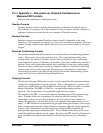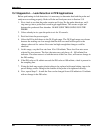
Appendices
224 UDA2182 Universal Dual Analyzer Product Manual January 2009
Faradaic Interferences
The DO probe responds to oxygen partial pressure as follows:
O
2
+ 4H
+
+ 4e
-
→ 2H
2
O (1)
Reaction (1) is a chemical reduction in which dissolved oxygen is reduced to water. This
reduction occurs at the working electrode, commonly referred to as the cathode. The
equal and opposite (oxidation) reaction occurs at the counter electrode (anode). Any
gaseous substance, which is permeable through the membrane and is capable of being
oxidized or reduced (electroactive) at the working electrode will interfere. Cl
2
, O
3
, H
2
,
N
2
H
4
and SO
2
are examples of interfering dissolved gases.
Cl
2
+ 2e
-
→ 2Cl
-
(2)
H
2
→ 2H
+
+ 2e
-
(3)
Reaction (2) is a reduction and hence a positive interference will be observed; reaction
(3) is an oxidation, which will result in a negative interference. All amperometric probes
are subject to reduction or oxidation interference as shown above. In addition to the
direct interference shown in these two equations, the equilibrium probe provides an
additional indirect interference. In normal probe operation oxygen is consumed at the
working electrode and an equal amount of oxygen is produced at the counter electrode.
In a positive interference condition, such as (2) above, chlorine is reduced at the working
electrode and an equivalent amount of oxygen is produced at the anode. This oxygen is
electroactive, along with the dissolved chlorine and is a contributor to the measured
current.
In the absence of dissolved oxygen and in a negative interference situation as in (3),
hydrogen gas is consumed at the working electrode and the opposite reaction, the
reduction of water to hydrogen gas occurs at the counter electrode. In this hydrogen
interference mode, the probe is both consuming and producing equal amounts of
hydrogen, and is operating in a hydrogen detection equilibrium mode.
In cases of electrochemical interference, if the interference is positive, dissolved oxygen
will be produced at the counter electrode giving a perceived higher oxygen reading. If
the interference is negative, dissolved hydrogen gas will be produced at the counter
electrode giving a perceived zero oxygen reading.
Sulfite Based Zero Testing
Often as a quick check to determine if a DO probe can reach 0.0 ppb, you can immerse
the probe in a solution of sodium sulfite (Na
2
SO
3
) or sodium meta bisulfite (Na
2
S
2
O
5
). A
2 to 5% by weight solution in water is sufficient. If available, a small level of coboltous
ion CO
2+
will act as a catalyst and speed up the reaction of oxygen with the scavenger.
Note: The lifetime of this solution is related to its exposure to air. Namely, the greater the
exposure, the shorter the lifetime.
However, a Honeywell proven low ppb DO test using Nitrogen, an oxygen displacer, is
recommended in Appendix M – Procedure for Low Level ppb Dissolved Oxygen Testing
of this manual.


















